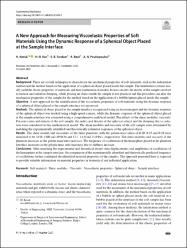Please use this identifier to cite or link to this item:
https://hdl.handle.net/20.500.11779/2041| Title: | A New Approach for Measuring Viscoelastic Properties of Soft Materials Using the Dynamic Response of a Spherical Object Placed at the Sample Interface |
| Authors: | Besli, Ayça Koç,Ömer Hayati Körük,Hasan Yurdaer, Berk Salih |
| Keywords: | Viscoelastic properties Sample interface Soft material Spherical object Shear modulus |
| Publisher: | Springer |
| Source: | Koruk, H., Koc, H. O., Yurdaer, S. B., Besli, A., & Pouliopoulos, A. N. (2023). A New Approach for Measuring Viscoelastic Properties of Soft Materials Using the Dynamic Response of a Spherical Object Placed at the Sample Interface. Experimental Mechanics, pp. 1-12. |
| Abstract: | Background: There are several techniques to characterize the mechanical properties of soft materials, such as the indentation method and the method based on the application of a spherical object placed inside the sample. The indentation systems usually yield the elastic properties of materials and their mathematical models do not consider the inertia of the sample involved in motion and radiation damping, while placing an object inside the sample is not practical and this procedure can alter the mechanical properties of the sample for the method based on the application of a bubble/sphere placed inside the sample. Objective: A new approach for the identification of the viscoelastic properties of soft materials using the dynamic response of a spherical object placed at the sample interface was proposed. Methods: The spherical object placed at the sample interface was pressed using an electromagnet and the dynamic response of the spherical object was tracked using a high-speed camera, while the dynamic response of the spherical object placed at the sample interface was estimated using a comprehensive analytical model. The effects of the shear modulus, viscosity, Poisson’s ratio and density of the soft sample, the radius and density of the spherical object and the damping due to radiation were considered in this mathematical model. The shear modulus and viscosity of the soft sample were determined by matching the experimentally identified and theoretically estimated responses of the spherical object. Results: The shear moduli and viscosities of the three phantoms with the gelatin mass ratios of 0.20, 0.25 and 0.29 were measured to be 3450, 4300 and 4950 Pa and 12.5, 14.0 and 15.0 Pa⋅s, respectively. The shear modulus and viscosity of the phantom increases as the gelatin mass ratio increases. The frequency of oscillations of the hemisphere placed at the phantom interface increases as the gelatin mass ratio increases due to stiffness increase. Conclusions: After matching the experimental and theoretical steady-state displacements and amplitudes of oscillations of the hemisphere at the sample interface, the comparison of the experimentally identified and theoretically predicted frequency of oscillations further confirmed the identified material properties of the samples. The approach presented here is expected to provide valuable information on material properties in biomedical and industrial applications. |
| URI: | https://hdl.handle.net/20.500.11779/2041 |
| ISSN: | 0014-4851 |
| Appears in Collections: | Makine Mühendisliği Bölümü Koleksiyonu Scopus İndeksli Yayınlar Koleksiyonu / Scopus Indexed Publications Collection WoS İndeksli Yayınlar Koleksiyonu / WoS Indexed Publications Collection |
Files in This Item:
| File | Description | Size | Format | |
|---|---|---|---|---|
| A-New-Approach-for-Measuring-Viscoelastic-Properties-of-Soft-Materials-Using-the-Dynamic-Response-of-a-Spherical-Object-Placed-at-the-Sample-InterfaceExperimental-Mechanics.pdf | Full Text- Article | 1.64 MB | Adobe PDF |  View/Open |
CORE Recommender
Sorry the service is unavailable at the moment. Please try again later.
Items in GCRIS Repository are protected by copyright, with all rights reserved, unless otherwise indicated.